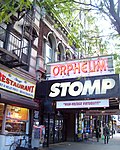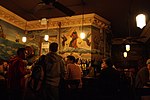Middle Collegiate Church
1628 establishments in the Dutch Empire17th-century Calvinist and Reformed churches19th-century Protestant churches2020 firesBuilding collapses caused by fire ... and 12 more
Building collapses in 2020Building collapses in the United StatesBuilding fires in New York CityBurned religious buildings and structures in the United StatesChurches completed in 1891Churches in ManhattanEast Village, ManhattanFormer Dutch Reformed churches in New York (state)Gothic Revival church buildings in New York CityReformed Church in America churchesReligious organizations established in 1628Second Avenue (Manhattan)

The Middle Collegiate Church is a dually aligned United Church of Christ and Reformed Church in America church located at 112 Second Avenue between 6th and 7th Streets in the East Village neighborhood of Manhattan, New York City.The Gothic Revival church was built from 1891 to 1892 as the congregation's fourth location, and was designed by Samuel B. Reed. It featured stained-glass windows by Louis Comfort Tiffany. It is located within the East Village/Lower East Side Historic District. It is part of the Collegiate Reformed Protestant Dutch Church. On December 5, 2020, the church was gutted by a fire that left only its stone exterior and its bell intact.
Excerpt from the Wikipedia article Middle Collegiate Church (License: CC BY-SA 3.0, Authors, Images).Middle Collegiate Church
East 7th Street, New York Manhattan
Geographical coordinates (GPS) Address Website External links Nearby Places Show on map
Geographical coordinates (GPS)
| Latitude | Longitude |
|---|---|
| N 40.727732 ° | E -73.988092 ° |
Address
Middle Collegiate Church (New Middle Collegiate Church)
East 7th Street
10009 New York, Manhattan
New York, United States
Open on Google Maps







